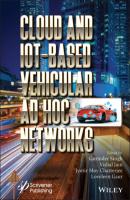Cloud and IoT-Based Vehicular Ad Hoc Networks. Группа авторов
Чтение книги онлайн.

Читать онлайн книгу Cloud and IoT-Based Vehicular Ad Hoc Networks - Группа авторов страница 24
Название: Cloud and IoT-Based Vehicular Ad Hoc Networks
Автор: Группа авторов
Издательство: John Wiley & Sons Limited
Жанр: Автомобили и ПДД
isbn: 9781119761822
isbn:
With the advancement in transportation Technologies Information and Communication System have introduced a new opportunity in hardware, software and communication for sustainable environment. The ICT enables better infrastructure and safety for passengers in the transportation with the amalgamation of ITS. Implementation of ITS mainly depends upon gathering and processing of data from the location. Normally, there are two classes of sensing platforms that are used: (i) Collection of data about vehicle conditions is done by Intra-Vehicular sensing and (ii) Collection of data regarding traffic conditions is carried out by Urban sensing. For data collection in Intra-Vehicular sensing, sensor technology is an essential element used, and then the data provided for further processing and analysis of transportation management systems.
3.2 Elements of ITS
Intelligent Transport System uses new cutting-edge technology for road traffic issues, like road accidents, congestion and needs three significant elements for establishing such as position, planning, and communication. PS/GSM is one of the modules used for location due to its low-cost. Figure 3.1 depicts the elements of ITS.
Figure 3.1 Elements of ITS.
Mapping is an innovation that plots area data and it tends to be acknowledged with the assistance of an advanced channel. Interchanges can be perceived by means of an assortment of media communications and broadcasting originality, for example, FM multiplex telecom, cell phones, and so on. These correspondence media should be contemplated and chosen by the sorts of ITS applications since they have fluctuating qualities, for example, long-range or short-go, single direction or twoway, and free or expense-based, an ideal mix of correspondence media. Notwithstanding setting up normal correspondence frameworks, techniques, and information positions, in addition to other things, it is essential to find out the locally available unit, side of the road units, and the frameworks, in addition to other things, that are perfect with every single accessible application.
3.3 Role of ITS in Safety
By lessening the chance of an accident, by decreasing the injury results of
accidents, and by affecting or controlling driver presentation to the road
traffic framework for example exposure measures, with variable speed constraining frameworks, the accompanying systems minimize the lesions and fatalities.
In-vehicle variable speed alerting and limiting.
In-vehicle forward crash notice
In-vehicle incident management system
Automated speed implementation
Roadside speed control frameworks with variable speed limits
Motorway control arrangement.
Different frameworks looked into which may seem to have impressive potential to diminish crash chance, however less significantly than those recognized above, incorporates: Lane takeoff cautioning, Lane change impact cautioning, Vision upgrade, and crash information recorders. Except for the last, these frameworks require further refinement and trialing before a progressively exact measure of their capability to decrease crashes are regularly made.
On the possibility of the literature assessment, versatile control and back impact notice frameworks are the applications that seem to have the lit-tlest sum potential to downsize injury crashes over the whole transport. Variable speed cautioning and restricting appeared to directly decrease vehicle speed and can, and as a result, have a major general impact in diminishing the injury outcomes of accidents. Adding to this safety belt update, interlock and insightful limitations offer huge security benefits.
3.4 Sensor Technologies
Sensor Technology has merit in transforming a traditional unit into the latest one. An element is one that provides an output signal relating to an input physical quantity (Figure 3.2).
Figure 3.2 Implanted vehicle sensors in ITS [5].
Sensor alarms the operators about the fault occurrence in manufacturing units.
Sensor supports the operators to reduce interruption in production system.
Necessity of skilled and experienced manpower is less.
Better Product quality can be obtained.
Generally, the output is an electrical quantity and the input measure is a physical quantity and the sensors are used in traffic control and safety transportation, etc. To increase the drivers, passenger satisfaction, and safety, recently the manufacturing of vehicles implemented sensors [4]. Some sensors are installed to monitor and control the performance, vehicle position, efficiency and safety system. Normally, an average of 50–100 number of sensors are available in a vehicle. For a smarter vehicle, the number of sensors is more than 200 sensors per vehicle [5]. Based on the type of sensor application, vehicle sensors are categorized as safety, diagnostics, convenience, and environment monitoring [6, 34].
The following sensors are used in the Transportation Systems:
1 Safety Sensor: The purpose is to recognize accident hazard events almost in real-time and form the basis of safety systems.Example: Micro-Mechanical Oscillator, Speed Sensor, Camera Sensor, Inertial Sensor, Ultrasonic Sensor, and Proximity Sensors, etc.
2 Diagnostic Sensor: The purpose is to detect and support the real-time information vehicle performance and position.Example: Position and Temperature Sensor, Gas Sensor, Pressure Sensor, Airbag Sensor, etc.
3 Assistance Sensor: The purpose is to collect the data that helps for comfortable usage.Example: Gas Sensor, Humidity Sensor, Position Sensor, and Torque Sensor, etc.
4 Environment Sensor: The purpose is to offer drivers and passengers alert warning services and monitors the environmental conditions.Example: Pressure Sensor, Temperature Sensor, Distance Sensor, etc.
5 Traffic Sensor: The purpose is to monitor and improve the traffic conditions in specific zones.Example: Ultrasonic and Proximity Sensors etc.
3.4.1 Implanted Vehicle Sensor Applications
The proximity sensor is to detect the closeness of any object to a vehicle. The ultrasonic sensor is to convert the input signal into an electrical signal. The target object distance is obtained through emission of ultrasonic sound waves and threshold limit which alert the driver and to the processing unit. The vehicle СКАЧАТЬ